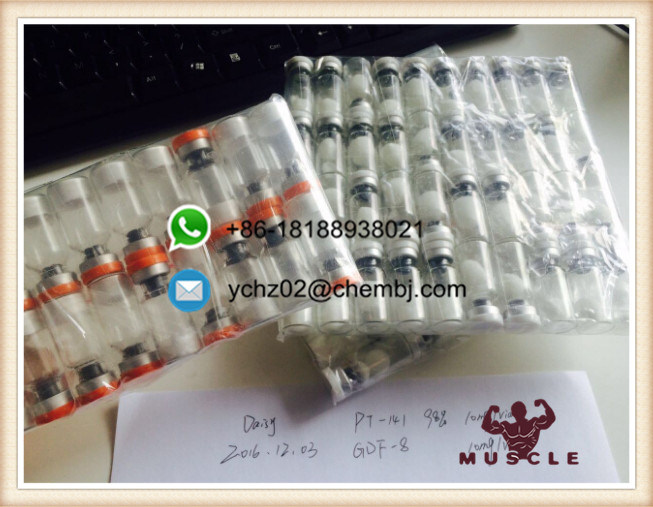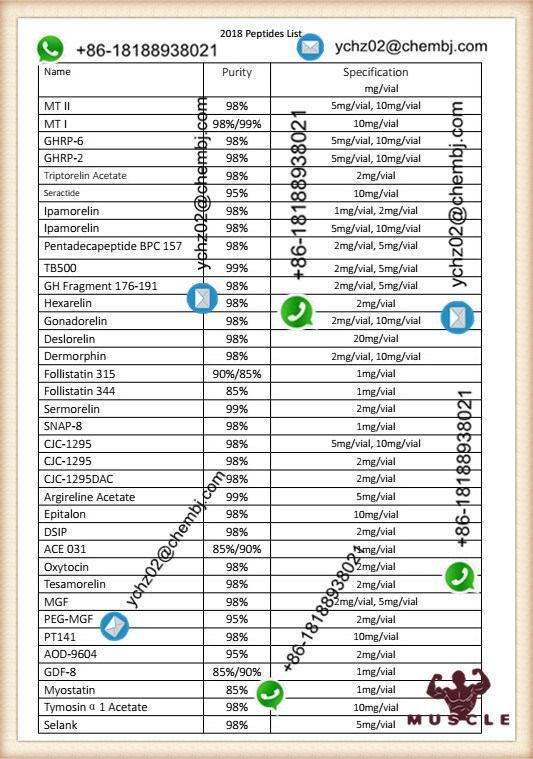Model NO.: 901758-09-6
Trademark: Muslce Man
Transport Package: As your required
Specification: 10mg/vial
Origin: China
Model NO.: 901758-09-6
Trademark: Muslce Man
Transport Package: As your required
Specification: 10mg/vial
Origin: China
Bodybuilding Peptides of  1mg/Vial Myostatin Gdf-8Detail:
Product name: GDF-8 (Growth Differentiation Factor 8Â Myostatin)
Purity: >98%
Specification: 1mg
Storage:2-8 degree centigrade refrigerator
Package: 10 Vials/Kit
Deliver:1 working day for ready goods,7 days to your destination.
Pacakge:1kit=10vials Alumnium foil+bubble+carton
Customized:accepted.
Country of Origin: China
Description:
Myostatin (GDF-8), a member of the TGFbeta superfamily, is a potent and specific negative regulator of skeletal muscle mass. In serum, myostatin circulates as part of a latent complex containing myostatin propeptide and follistatin-relatedgene. The myostatin propeptide is known to bind and inhibit myostatin in vitro. This interaction is relevant in vivo, with a majority (>70%) of myostatin in serum bound to its propeptide. The myostatin propeptide is negative regulator of myostatin in vivo.Description:28 kDa protein containing 243 amino acid residues of the human Myostatin Propeptide and 5 additional amino acid residues.
Myostatin (also known as growth differentiation factor 8, abbreviated GDF-8) is a myokine, a protein produced and released by myocytes that acts on muscle cells' autocrine function to inhibit myogenesis: muscle cell growth and differentiation. In humans it is encoded by the MSTN gene. Myostatin is a secreted growth differentiation factor that is a member of the TGF beta protein family.
Animals either lacking myostatin or treated with substances that block the activity of myostatin have significantly more muscle mass. Furthermore, individuals who have mutations in both copies of the myostatin gene have significantly more muscle mass and are stronger than normal. Blocking the activity of myostatin may have therapeutic application in treating muscle wasting diseases such as muscular dystrophy.
Applications:
The gene encoding myostatin was discovered in 1997 by geneticists Se-Jin Lee and Alexandra McPherron who produced a strain of mutant mice that lack the gene. These myostatin "knockout" mice have approximately twice as much muscle as normal mice. These mice were subsequently named "mighty mice".
Naturally occurring deficiencies of myostatin have been identified in cattle by Ravi Kambadur, whippets, and humans; in each case the result is a dramatic increase in muscle mass. A mutation in the 3' UTR of the myostatin gene in Texel sheep creates target sites for the microRNAs miR-1 and miR-206. This is likely to cause the muscular phenotype of this breed of sheep.
Human myostatin consists of two identical subunits, each consisting of 109 (NCBI database claims human myostatin is 375 residues long) amino acid residues. Its total molecular weight is 25.0 kDa. The protein is inactive until a protease cleaves the NH2-terminal, or "pro-domain" portion of the molecule, resulting in the active COOH-terminal dimer. Myostatin binds to the activin type II receptor, resulting in a recruitment of either coreceptor Alk-3 or Alk-4. This coreceptor then initiates a cell signaling cascade in the muscle, which includes the activation of transcription factors in the SMAD family - SMAD2 and SMAD3. {{|}}These factors then induce myostatin-specific gene regulation. When applied to myoblasts, myostatin inhibits their differentiation into mature muscle fibers.
Myostatin also inhibits Akt, a kinase that is sufficient to cause muscle hypertrophy, in part through the activation of protein synthesis. However, Akt is not responsible for all of the observed muscle hyperthrophic effects which are mediated by myostatin inhibition[8] Thus myostatin acts in two ways: by inhibiting muscle differentiation, and by inhibiting Akt-induced protein synthesis.
Treat muscle atrophy, strengthen muscle toughness,Increase muscle number
Treating malnutrition patients is an important index of the strength training athletes
GDF-8 can effectively prevent the increased due to age brings the increase of adipose tissue, and reduce the occurrence of diabetes and obesity.

Hot Peptides:

 Bodybuilding Peptides of  1mg/Vial Myostatin Gdf-8
Detail:
Product name: GDF-8 (Growth Differentiation Factor 8Â Myostatin)
Purity: >98%
Specification: 1mg
Storage:2-8 degree centigrade refrigerator
Package: 10 Vials/Kit
Deliver:1 working day for ready goods,7 days to your destination.
Pacakge:1kit=10vials Alumnium foil+bubble+carton
Customized:accepted.
Country of Origin: China
Description:
Myostatin (GDF-8), a member of the TGFbeta superfamily, is a potent and specific negative regulator of skeletal muscle mass. In serum, myostatin circulates as part of a latent complex containing myostatin propeptide and follistatin-relatedgene. The myostatin propeptide is known to bind and inhibit myostatin in vitro. This interaction is relevant in vivo, with a majority (>70%) of myostatin in serum bound to its propeptide. The myostatin propeptide is negative regulator of myostatin in vivo.Description:28 kDa protein containing 243 amino acid residues of the human Myostatin Propeptide and 5 additional amino acid residues.
Myostatin (also known as growth differentiation factor 8, abbreviated GDF-8) is a myokine, a protein produced and released by myocytes that acts on muscle cells' autocrine function to inhibit myogenesis: muscle cell growth and differentiation. In humans it is encoded by the MSTN gene. Myostatin is a secreted growth differentiation factor that is a member of the TGF beta protein family.
Animals either lacking myostatin or treated with substances that block the activity of myostatin have significantly more muscle mass. Furthermore, individuals who have mutations in both copies of the myostatin gene have significantly more muscle mass and are stronger than normal. Blocking the activity of myostatin may have therapeutic application in treating muscle wasting diseases such as muscular dystrophy.
Applications:
The gene encoding myostatin was discovered in 1997 by geneticists Se-Jin Lee and Alexandra McPherron who produced a strain of mutant mice that lack the gene. These myostatin "knockout" mice have approximately twice as much muscle as normal mice. These mice were subsequently named "mighty mice".
Naturally occurring deficiencies of myostatin have been identified in cattle by Ravi Kambadur, whippets, and humans; in each case the result is a dramatic increase in muscle mass. A mutation in the 3' UTR of the myostatin gene in Texel sheep creates target sites for the microRNAs miR-1 and miR-206. This is likely to cause the muscular phenotype of this breed of sheep.
Human myostatin consists of two identical subunits, each consisting of 109 (NCBI database claims human myostatin is 375 residues long) amino acid residues. Its total molecular weight is 25.0 kDa. The protein is inactive until a protease cleaves the NH2-terminal, or "pro-domain" portion of the molecule, resulting in the active COOH-terminal dimer. Myostatin binds to the activin type II receptor, resulting in a recruitment of either coreceptor Alk-3 or Alk-4. This coreceptor then initiates a cell signaling cascade in the muscle, which includes the activation of transcription factors in the SMAD family - SMAD2 and SMAD3. {{|}}These factors then induce myostatin-specific gene regulation. When applied to myoblasts, myostatin inhibits their differentiation into mature muscle fibers.
Myostatin also inhibits Akt, a kinase that is sufficient to cause muscle hypertrophy, in part through the activation of protein synthesis. However, Akt is not responsible for all of the observed muscle hyperthrophic effects which are mediated by myostatin inhibition[8] Thus myostatin acts in two ways: by inhibiting muscle differentiation, and by inhibiting Akt-induced protein synthesis.
Treat muscle atrophy, strengthen muscle toughness,Increase muscle number
Treating malnutrition patients is an important index of the strength training athletes
GDF-8 can effectively prevent the increased due to age brings the increase of adipose tissue, and reduce the occurrence of diabetes and obesity.

Hot Peptides:

Â